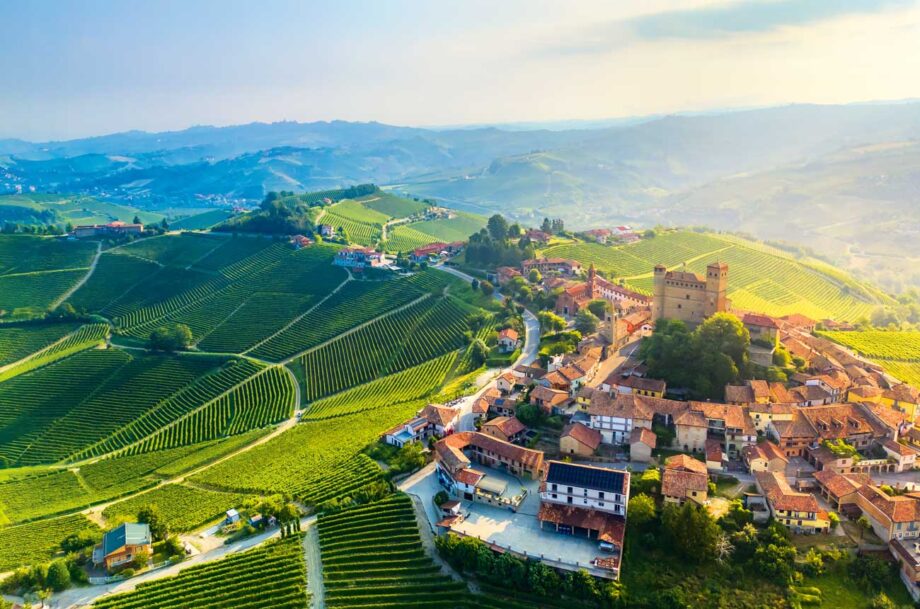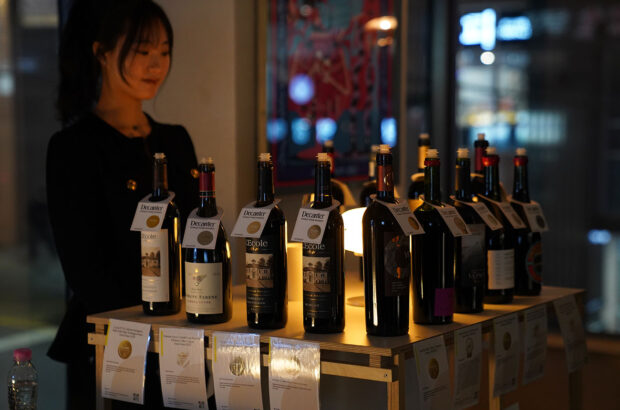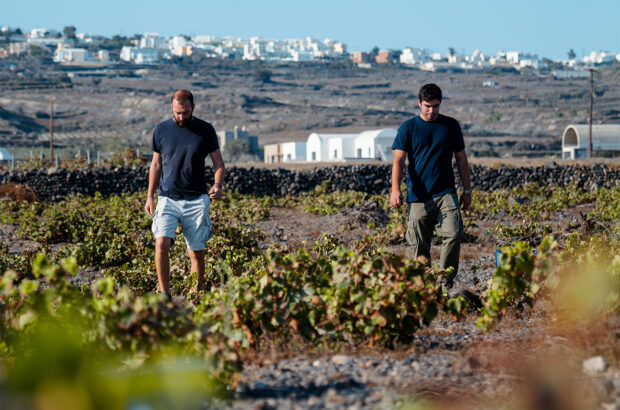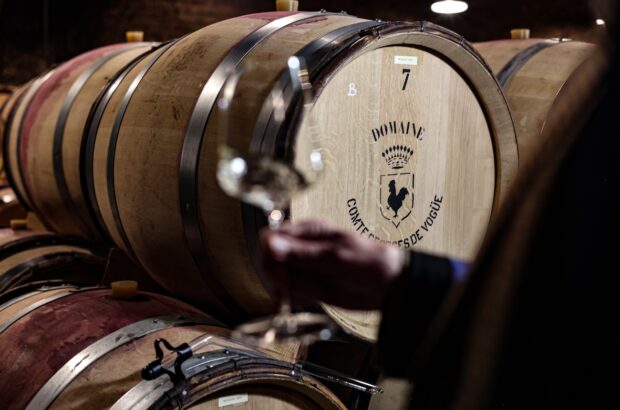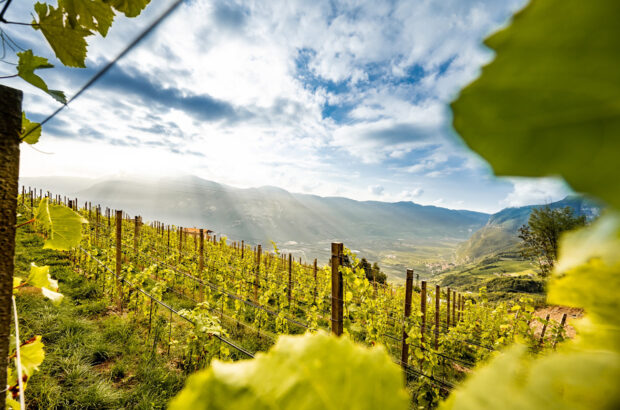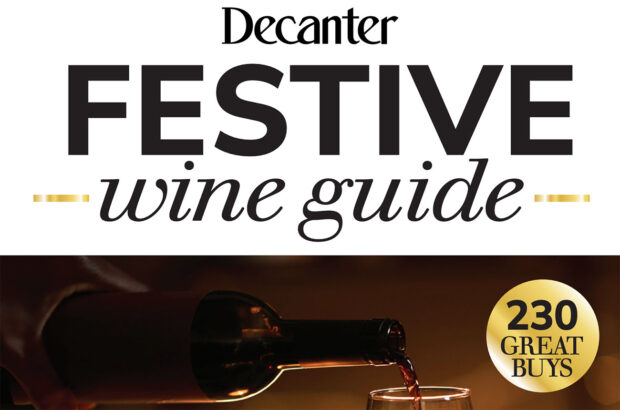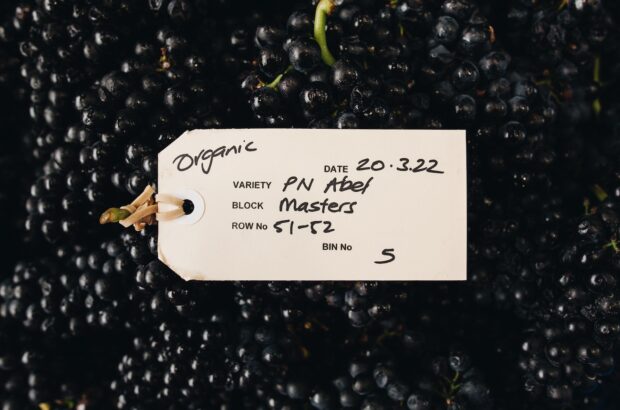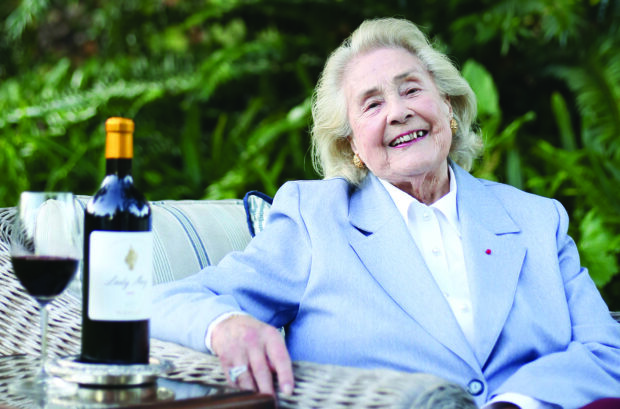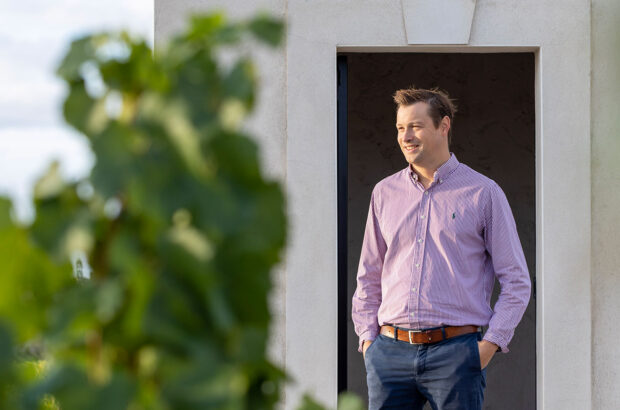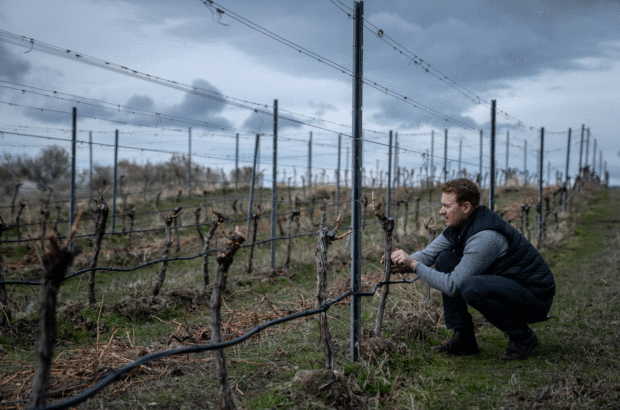In the hills of the Langhe, southeast of Turin in Italy’s Piedmont region, visitors will find outstanding wines and breathtaking landscapes. A patchwork of vineyards and hazelnut groves, it’s home to Michelin-starred restaurants, family-run osterias, stylish wine bars, and both historic and modern wineries – the sources of the global fame of Barolo and Barbaresco DOCGs.
Although it may feel like another world, the Langhe is within easy reach for international travellers – wine lovers can arrive at the airports of Turin, Milan or Genoa. Approaching the Langhe and the regional capital of Alba in a hire car (a necessity), the view is characterised by rolling hills intersected by the Tanaro river and winding roads revealing new vistas around every bend. Charming villages are nestled among undulating vineyards dotted with ancient towers and castles. And to the west, on a clear day, the snow-capped Alps form the perfect backdrop. If you are fortunate enough to be visiting this enchanting region, here is a five-day guide to help you make the most of your time.
Day 1: Barolo & La Morra
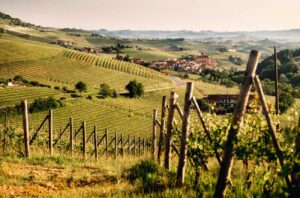
The village of Barolo, dominated by the imposing Falletti castle
What better place to begin your journey than in the village of Barolo? From the west-facing side of the sumptuous Falletti castle in the village (be sure to visit the wine museum that the castle houses), take a short walk down Via Roma to the ancient cellars of
Marchesi di Barolo. They offer guided tours that include visits to the underground cellars and wine library, followed by various wine tasting packages in the wine shop. On the upper floor, enjoy typical Langhe cuisine in La Foresteria restaurant, open daily, where each course may be paired with wine produced at the estate’s winery. It’s a fine feeling to be sipping elegant Barolos and the graceful Peiragal Barbera d’Alba Superiore just across the road from the Paiagallo cru vineyards, where the grapes for the Barbera Superiore are cultivated.
After lunch, continue your stroll through the village and stop off at Purpleryta, tucked down Via Vittorio Emanuele, to paint with wines in one of Rita Barbero’s creative wine painting classes. Then, jump in the car and drive 10 minutes to the hilltop town of La Morra, which overlooks Barolo with stunning viewpoints. From Piazza Martiri, take walking trail No7, known as the Sentiero del Barolo (see, ‘Visit Langhe’). It winds around the village and among historic vineyards for 11.5km and can be done either on foot (allow a good 3.5 hours) or by mountain bike. Along the way, stop at Marrone, near Annunziata, which offers tasting tours and fun half-day cookery classes with chef Paolo Garabell. Enjoy a delicious aperitif and a cellar tour with Denise Marrone. Then indulge yourself with a meal in the winery’s restaurant comprising the dishes you prepared earlier, paired with wines crafted by winemaker Valentina Marrone.
Alternatively, discover the Cerequio vineyard, which gives its name to the wine retreat Palás Cerequio, lying among the vineyards about 2km south of La Morra itself. Operated by esteemed wine producer Michele Chiarlo, the retreat presents 11 elegant suites, all named after historic Barolo vineyards. Enjoy a glass of a fruity Dolcetto on the spectacular CerequioSkyBar terrace before partaking of the finest Piemontese menu at La Corte, the in-house restaurant (open for lunch Saturday and Sunday, dinner Wednesday to Saturday). In its cellar resides the liquid history of Michele Chiarlo’s winery: more than half a century of Barolo vintages.
Day 2: Monforte d’Alba
Heading south out of Barolo, just off the SP163 road and just a five-minute drive from the village of Monforte d’Alba, stands the renowned winery of Domenico Clerico. Domenico sadly passed away in 2017, but his legacy lives on through his wife Giuliana and their niece Cecilia. Visitors can delve into these deep roots through a selection of curated tastings offering a comprehensive portrait of the Nebbiolo grape. The winery’s ageing cellar is a blend of tradition and modernity, showcasing artwork created by emerging artists who every year design the wine label for Domenico Clerico Arte Limited Edition, a blend of Nebbiolo and Barbera.
After your visit, if you’re hungry, Giuliana can book you in with her sister-in-law Laura, who runs Enoteca Rocca, a wine bar and café in the heart of Monforte – the perfect spot for a savoury breakfast, an Italian aperitif or a traditional lunch.
Afterwards, taking an immediate right outside the enoteca and driving up the narrow streets through the village, you will arrive at the Conterno-Fantino estate, founded by the two eponymous families in 1982. Perched at an impressive height, the open belvedere on the winery’s rooftop offers panoramic views of the Italian Alps.
The estate’s 27ha of organically farmed vineyards yield an annual production of 150,000 bottles, primarily from plots in Monforte d’Alba, including the historic Ginestra cru. The new generation – winemaker Fabio and his sister Elisa, with cousins Matteo and Noemi Conterno – offers guests a warm welcome into the estate’s futuristic cellar. After sampling a wide range of still wines, the tasting concludes with Barolo Chinato, a traditional bittersweet fortified wine infused with a blend of botanicals.
Next-door lies La Ribezza, a family-owned boutique retreat. This carefully restored villa, embellished with Art Nouveau details, offers 18 elegant rooms, the classy Bar Moda Deco and an outdoor pool with stunning views. Just a short walk down into town, in the historic Palazzo Martinengo, the hotel’s restaurant Moda Venue offers a refined dining experience with an extensive wine list.
Day 3: Serralunga d’Alba & towards Alba
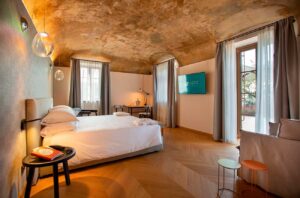
Four-star accommodation offered at Cascina Galarej, near Uccellaccio
Start your day with truffle hunting at Enrico Rivetto’s estate on the Lirano hill, near Serralunga d’Alba, to the east of Barolo village. Surrounded by picturesque natural forest, this 35ha biodynamically cultivated microcosm blends vineyards and mixed crops. Discover it through either of two fascinating guided tours: the ‘Biodiversity Walk’ (€15 per person) and ‘Lirano Woods Experience’ (€25). With a thirst suitably worked up, your visit might end with a separate tasting in Enrico’s home cellar, sampling his characterful reds alongside a white made from the rediscovered Piedmontese grape Nascetta. Rivetto also offers four refurbished apartments with private parking in central Alba, half an hour’s drive north.
On the SP125 road, head north in the direction of Uccellaccio until you arrive at the enchanting Villaggio Narrante. With 167 years of royal heritage, today the estate offers a heady mix of wine tours and tempting gourmet proposals. Visit the historic, in-house cellars of Fontanafredda and Casa E di Mirafiore, and take your pick of dining styles among the Michelin one-star Guidoristorante, the lively and informal Osteria Disguido (@osteriadisguido), or the recently opened and convivial Bar Fontana, all run by second-generation Alciati brothers Ugo (the chef), Piero and Andrea.
Villaggio Narrante also offers three distinct, four-star accommodation options: Cascina Galarej, a restored farmhouse with 10 suites and a spa with a heated pool; Le Case dei Conti Mirafiore, a former winery workers’ accommodation boasting 14 rooms with elegant Italian furnishings; and Foresteria delle Vigne, a former nursery with 11 well-presented rooms. The property is also equipped with a conference centre and a beautiful garden, making it an exceptional venue for special events, banquets and ceremonies.
A few kilometres north, along the SP3 on the outskirts of Alba, a must-visit destination is L’Acino (‘the grape’) at Monsordo Bernardina, Ceretto’s estate and winery. Here, the lively Arneis Blangé (first vintage 1985) and sensational reds are produced. Built in 2009, this futuristic glass bubble suspended over the rolling vineyard is the architectural symbol of Ceretto and offers a variety of wine tasting experiences seven days a week (but book ahead). The Ceretto family, winemakers since the 1930s, has developed several standout projects, from the colourful Cappella del Barolo chapel in the Brunate vineyard – a beloved art landmark transformed from a small, unconsecrated church by Sol LeWitt and David Tremlett in the late 1990s, and which has more than 100,000 visitors yearly – to the Michelin three-star Piazza Duomo and the traditional osteria La Piola in Alba, which is where you can head for dinner after tasting the family’s wines.
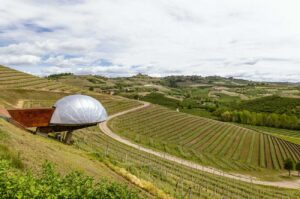
L’Acino perched above vineyards at Ceretto’s Monsordo estate, outside Alba
Day 4: Barbaresco & Treiso
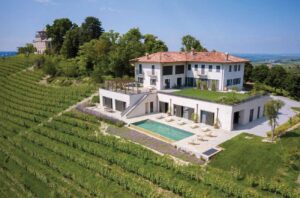
The Dai Grésy wine resort, with infinity pool and spa, near Treiso
Over to the east of Alba, begin the day exploring the celebrated wine enclave of Barbaresco, visiting Giuseppe Cortese. Daily visits to this artisanal estate nestled within the prestigious cru vineyard of Rabajà are guided by Gabriele and Tiziana Cortese, who can also welcome you to their cosy three-room B&B with stunning views.
Just five minutes’ drive away stands the estate of the Marchesi di Grésy which has been in the noble di Grésy family since 1797. The historic cellar is surrounded by the extraordinary Martinenga, the largest monopole vineyard in the Barbaresco DOCG. Different tasting journeys are proposed (ranging from €30-€90 per person), including vertical line-ups of the finest Barbaresco. Another option for accommodation in Barbaresco is the estate’s thoughtfully restored 11-room wine resort Dai Grésy, where guests can relax in the saltwater infinity pool and take advantage of the on-site spa. Homemade recipes, combined with in-house wine tastings, are exclusively reserved for the clientele.
It’s now time for lunch. Walking up the village’s main street, you get a glance of Barbaresco’s majestic tower. At its foot, a traditional meal is available at Osteria Antica Torre – a must-try during your stay. Daily, siblings Stefania, Paola and Maurizio cook tajarin, the typical hand-cut egg noodles that are delicious served with freshly shaved truffle.
After lunch, head south via the SP3 and SP138 to Treiso, another Langhe gem. In the heart of the village is La Ciau del Tornavento, a stylish Michelin one-star restaurant located in a building constructed in the littorio style in 1931. Chef Maurilio Garola and co-owner Nadia Benech specialise in agnolotti del plin di seirass (small homemade ravioli stuffed with a traditional dry ricotta cheese aged in hay). While there, be sure to ask for a tour of the outstanding underground cellar which houses more than 6,000 labels, with 60,000 bottles in stock.
On the restaurant’s doorstep lies the 31ha estate of the Grasso family, Ca’ del Baio. Here, book ahead to organise a tasting of the estate red wines in the family home. Upon special request, you can also enjoy vineyard aperitifs featuring the family’s white wines – an indulgent treat proposed by the three daughters Paola, Valentina and Federica.
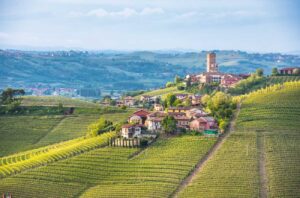
The tower rising above Barbaresco village offers enviable views of the Langhe. Credit: Javarman3 / Getty Images
Day 5: Alba
Kick off your final day by exploring Alba, the beating heart of the Langhe, marked by medieval towers and home to the renowned International White Truffle Fair (11 October-8 December). Built atop Roman ruins, the city offers underground tours to reveal its deep roots. Don’t miss Pio Cesare winery, a true gem literally carved into Alba’s foundations. Built at the end of the 1700s, the cellars are surrounded by Roman walls dating back to 50 BCE. Significant renovations have been made over the years to restructure the facilities, including a new ageing room 12 metres beneath the existing building. Book a private guided tour (by appointment only) and pick a wine tasting to suit you, ranging from six to nine wines from across the Pio Cesare range, premium selections (featuring the highly rated, old-vine and single-vineyard Barolo Mosconi bottling), or the ultimate: a tasting of seven historic vintages that will include a mix of mature Barbaresco and Barolo wines.
Alba is the epicurean cradle of the Langhe. Among the small galaxy of enogastronomic hotspots rises Voglia di Vino, a charming wine bar and restaurant that’s ideal for sampling a wide range of crisp, sparkling Alta Langa, either as an aperitif or over lunch (Tuesday to Sunday), and featuring classics such as vitello tonnato (thinly sliced boiled veal served with a tuna sauce flavoured with capers and anchovies). If you need to stay one more night, there is also a charming, three-room B&B available upstairs, which offers a practical stopover right in the centre of town.
After lunch, consider the leisurely 25-minute drive southeast down the SP429 to Cascina Pistone, home to unconventional cheese-makers Silvio and Tommaso Pistone. They breed about 30 Langa sheep and craft raw sheep’s milk cheeses, such as Tuma di Langa, using traditional methods. Tastings and wholesome farm-style lunches are offered by reservation only, each visit offering an authentic immersion into the essence of Piemontese artisanship and hospitality.
Return to Alba for a final gastronomic experience. A few streets away from Voglia di Vino, in Piazza Michele Ferrero, are Enoclub and Caffé Umberto, two distinct restaurants with a shared entrance. Caffè Umberto’s contemporary atmosphere is perfect for lunches or informal dinners, while on the lower level in the ancient cellar, Enoclub proposes a more intimate ambience with original masonry, a refined, dynamic food menu and a great wine selection comprising prestigious names, rising stars and organic artisan producers.
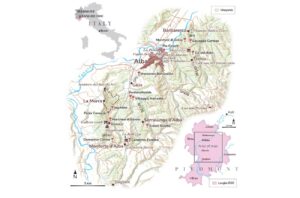
Credit: JP Map Graphics Ltd


